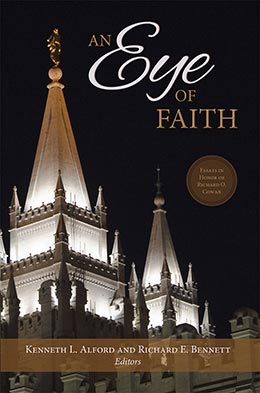Prophets Rendering Christlike Service: Looking to Peter as an Example
Kenneth L. Alford
Kenneth L. Alford, “Prophets Rendering Christlike Service: Looking to Peter as an Example,” in An Eye of Faith: Essays in Honor of Richard O. Cowan, ed. Kenneth L. Alford and Richard E. Bennett (Provo, UT: Religious Studies Center; Salt Lake City, 2015), 213–33.
Kenneth L. Alford was an associate professor of Church history and doctrine at Brigham Young University when this article was published.
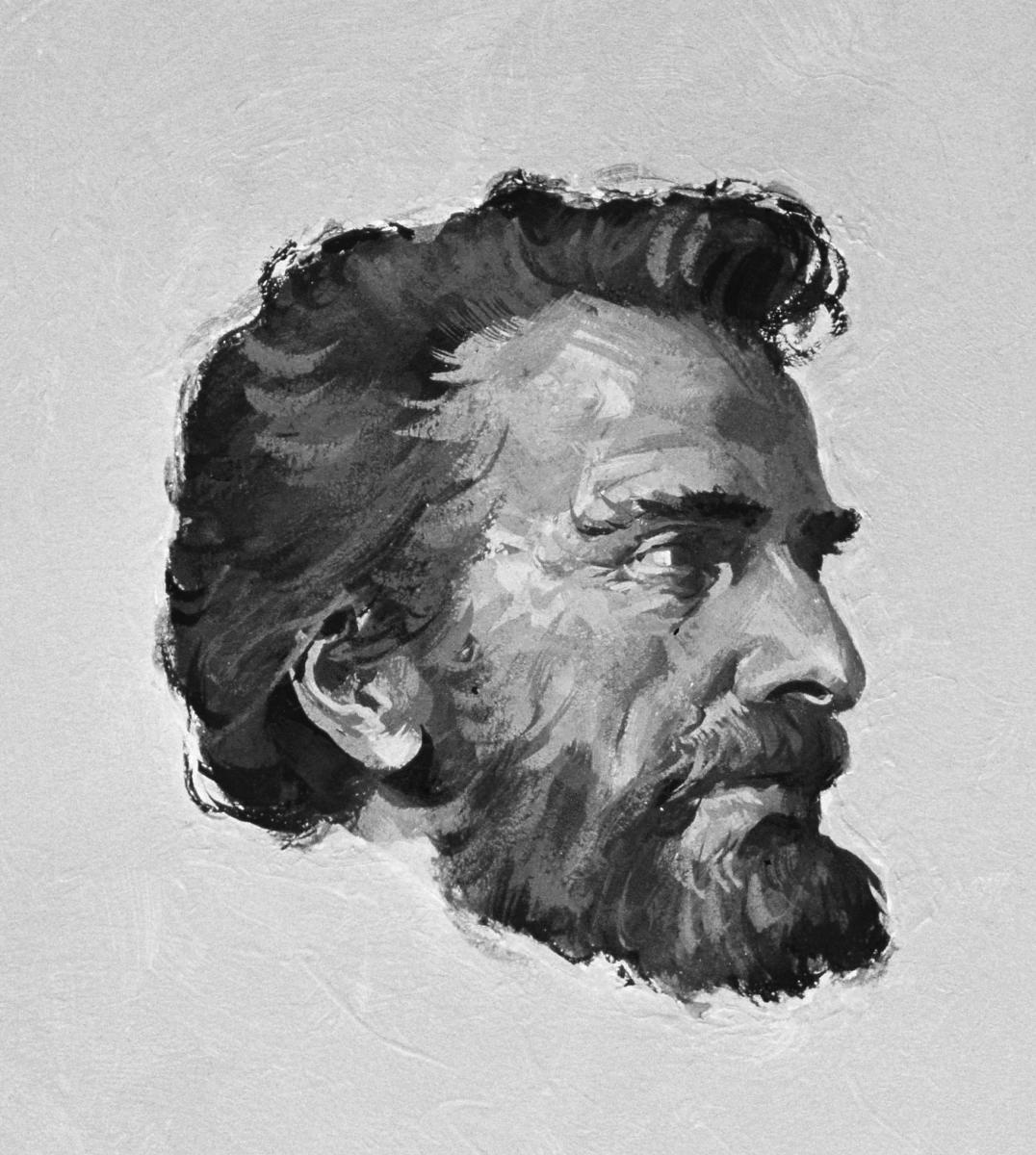 This painting of the Apostle Peter was commissioned for the Mormon Pavilion at the New York World's Fair, 1964-65. (Painting by Harold T. Kilbourn.)
This painting of the Apostle Peter was commissioned for the Mormon Pavilion at the New York World's Fair, 1964-65. (Painting by Harold T. Kilbourn.)
The New Testament primarily portrays Peter acting in his calling as the chief Apostle. However, the Gospels and the book of Acts also include incidents from Peter’s life where he is shown providing service to people in need. Those brief vignettes into Peter’s character include inviting Christ to his home so that his mother-in-law could be healed (see Matthew 8:14–15), Peter’s healing of a man named Æneas at Lydda (see Acts 9:32–34), and raising Tabitha from the dead at Joppa (see Acts 9:36–42).
The opening verses of Acts chapter 3 relates an incident from Peter’s life that provides additional insights into his compassionate character. Luke records that Peter and John[1] entered “into the temple at the hour of prayer, [being] the ninth [hour]” (Acts 3:1). As they entered, their attention was drawn to a man who had been lame since birth—a man who sat near the Beautiful Gate[2] “every day to beg from those going into the temple courts” (Acts 3:2, New International Version).[3] The ninth hour is approximately 3:00 p.m.[4]—the traditional time for offering evening prayer.[5] The man may have been begging alms that entire day as he most likely did every day, and he almost certainly would have been tired and uncomfortable. Seeing Peter and John, the man begged alms from them.[6]
For several years, Peter had watched the Savior continually bless, heal, and minister to the people with whom he came into contact. He had heard Christ’s frequent admonitions to show mercy and love in order to bless the lives of others. Peter had watched numerous times as the Savior healed “the lame to walk” (Matthew 15:31), commanded “the sick of the palsy,” and blessed the “halt, [and] withered” to “rise up and walk” (Luke 5:18–26, John 5:2–9). Now Peter found himself in a perfect setting to “go, and do thou likewise” (Luke 10:37) as the Savior had admonished. Giving the lame man his complete attention—“fastening his eyes upon him” (Acts 3:4), according to Luke—Peter charged the man to “Look at us!” (Acts 3:4, New International Version). Expecting to receive money from Peter or John, the lame man “gave heed unto them” (Acts 3:5).
What Peter did next must have briefly disappointed the crippled man. Instead of receiving a few coins, he heard Peter say: “Silver or gold have I none” (Acts 3:6). The lame man’s initial disappointment would quickly turn to astonishment and thanksgiving, though, as Peter continued: “But such as I have give I thee: In the name of Jesus Christ of Nazareth rise up and walk” (Acts 3:6). Anciently as today, invoking the name of Jesus Christ with proper priesthood authority “carried the power and authority of the person” manifesting that “the leaders of the church possess[ed] the power once operating through Jesus.”[7]
Demonstrating his personal faith and confidence in the power of the priesthood, Peter reached down, took the lame man “by the right hand, and raised him up” (Acts 3:7, American Standard Version). The miracle occurred immediately.[8] Luke, the physician-author of Acts, noted that “his feet and ankle bones received strength,” and “he leaping up stood, and walked, and entered with them into the temple, walking, and leaping, and praising God” (Acts 3:7–8).[9] Peter’s compassion and priesthood had positively changed the man’s life forever.
Charles Lindley Wood, Lord Halifax, once suggested, “Service is the rent we pay for our own room on earth.”[10] Peter could say, as did King Benjamin in the Book of Mormon, that he “had spent my days in your service, [but] I do not desire to boast, for I have only been in the service of God” (Mosiah 2:16). Following in Christ and Peter’s footsteps, latter-day prophets have each rendered a variety of compassionate, and usually private, service to others. While numerous examples are available from the lives of these sixteen great men, the pages that follow share an example of charity and compassion from the life of every President of The Church of Jesus Christ of Latter-day Saints from Joseph Smith Jr. in the nineteenth century to Thomas S. Monson in the twenty-first century.
Joseph Smith Jr.
Stories regarding the kindheartedness and generosity of the Prophet Joseph Smith are frequently repeated, but this incident is not generally as well known. In 1838, Joseph was playing ball with some of the local young men, who soon began to tire of the game. Noticing their decreasing interest in the sport, Joseph called the boys together and suggested that they should instead “build a log cabin” for a local widow—which they promptly did. Edwin Holden, who was one of those young boys, noted that such action “was Joseph’s way, always assisting in whatever he could.”[11]
Brigham Young
In the early 1860s, as President Young walked past the Tithing Office in downtown Salt Lake City, he noticed a barefoot boy with “ragged trousers and a worn out shirt” who was wearing a hat with a hole in it. President Young stopped, spoke with him, and then invited the young man to accompany him to his family store, where he instructed his store manager to “fit out this young man with new shoes and stockings and a new suit of clothes, a shirt and a hat, that will fit him, and give him an extra shirt, two suits of underwear and an extra pair of stockings.” As he parted, he said, “Now, young man this gentleman will fix you up so that you will be the best dressed boy in Salt Lake City.”[12] The young man assisted that day, Ben E. Rich, later presided over several missions of the Church.
John Taylor
During the April 1880 general conference, President Taylor announced that as part of the Church’s fiftieth anniversary celebration, “We ought to do something, as they did in former times, to relieve those that are oppressed with debt, to assist those that are needy, to break the yoke off those that may feel themselves crowded upon, and to make it a time of general rejoicing.” Referring to the Old Testament practice of a jubilee year, he called for and received a sustaining vote that the Church would “release one-half of the whole” indebtedness from the $1.6 million in outstanding debts owed to the Perpetual Emigrating Fund for “those who are poor and that are struggling with difficulties in life.” He also encouraged individuals to forgive financial debts owed to them, as far as possible, promising that “if you will go to work and try to relieve them as much as you can, under the circumstances, God will relieve you when you get into difficulties.”[13] His example and encouragement reduced the financial burdens on numerous Latter-day Saints.
Wilford Woodruff
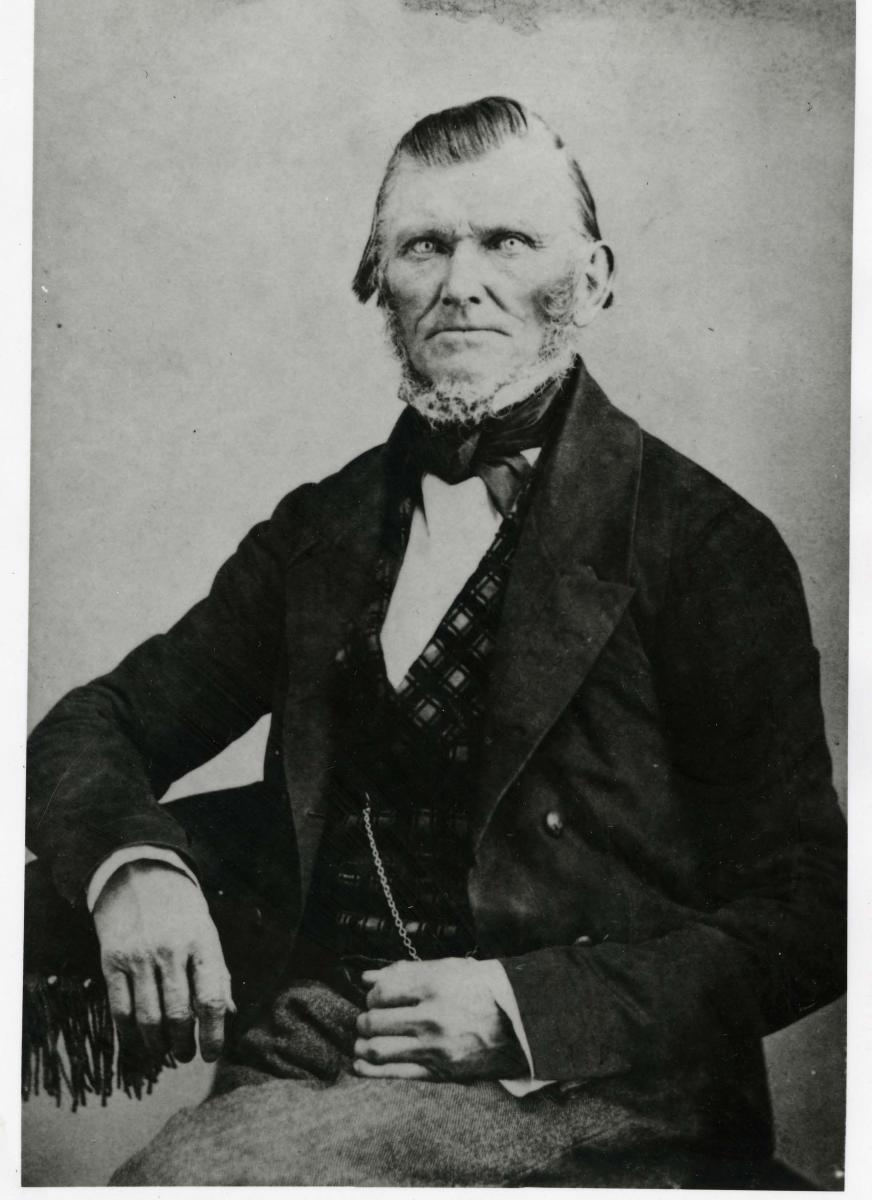 Portrait of Wilford Woodruff in his forties taken in Salt Lake City. As a younger man, Wilford had the opportunity to bless and care for his young wife and their newborn child. (Photo by Edward Martin, Church History Library.)
Portrait of Wilford Woodruff in his forties taken in Salt Lake City. As a younger man, Wilford had the opportunity to bless and care for his young wife and their newborn child. (Photo by Edward Martin, Church History Library.)
Wilford Woodruff exercised both his faith and his priesthood in 1838 while leading a group of fifty-three Saints from Maine to Illinois. On November 23, Phoebe, his wife of a year and a half who was still nursing their first child, began having severe headaches. Her health continued to fail day after day, and by December 1 Wilford confided to his journal that it seemed “as if she then would breathe her last lying in the wagon.” He “cried unto the Lord, and prayed that she might live,” and she revived. He then procured a tavern room so Phoebe and the baby could rest easier. The next morning, though, Phoebe called Wilford to her side and said that “she felt as though a few moments more would end her existence in this life. . . . To all appearances she was dying.” Elder Woodruff “laid hands upon her and prayed for her.” She revived and slept a little that night. On December 3, though, she “seemed to be gradually sinking, and in the evening her spirit apparently left her body, and she was dead.”
As he looked in sorrow upon his wife’s body, Elder Woodruff recorded that the “spirit and power of God began to rest upon me” and “faith filled my soul, although she lay before me as one dead.” He consecrated some oil he had with him and anointed his wife’s body, laid his hands upon her, and rebuking the power of death he commanded “the spirit of life to enter her body.” She awoke and “from that hour she was made whole.” After recuperating for a few days, Elder Woodruff related that “the Spirit said to me: ‘Arise, and continue thy journey!’” Phoebe arose out of bed, dressed herself, “walked to the wagon, and we went on our way rejoicing.”[14] (Phoebe lived for another forty-seven years.)
Lorenzo Snow
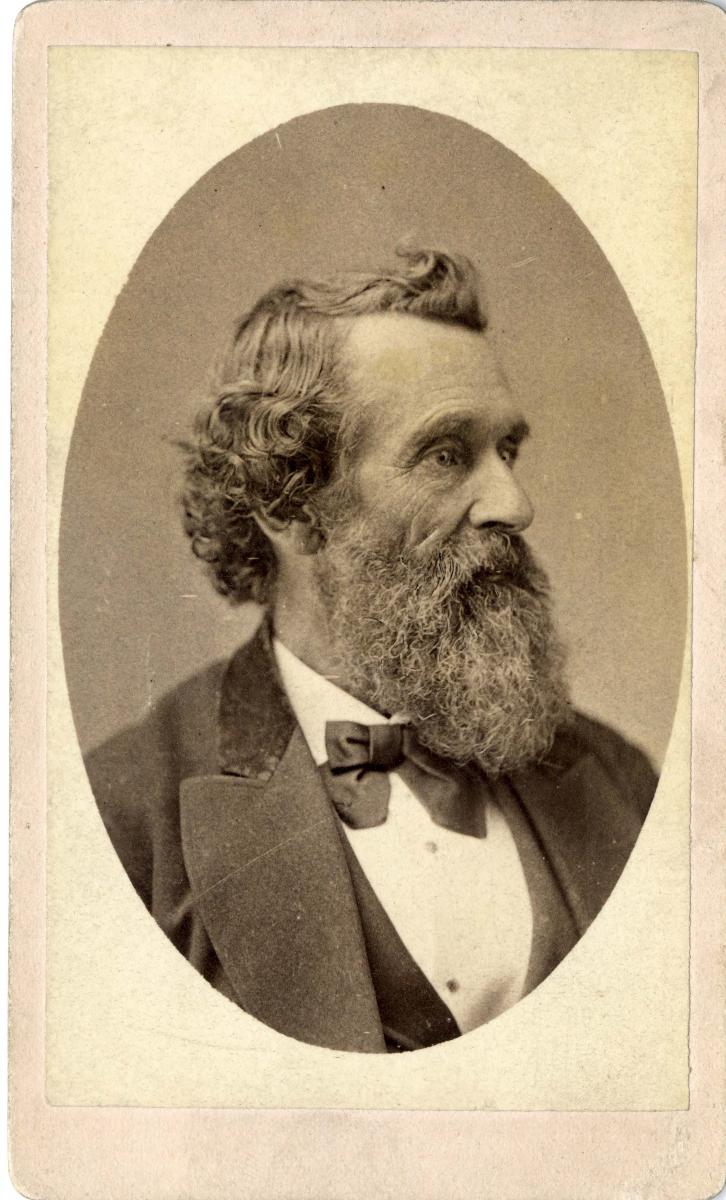 Lorenzo Snow's experience as a missionary in Italy helped to prepare him for a lifetime of service. (Photo by Charles Roscoe Savage, Church History Library.)
Lorenzo Snow's experience as a missionary in Italy helped to prepare him for a lifetime of service. (Photo by Charles Roscoe Savage, Church History Library.)
While serving in September 1850 as a missionary in the Piedmont region of the Italian Alps, Lorenzo Snow had a miraculous healing experience similar to that of his father-in-law, Wilford Woodruff.[15] On the morning of September 6, Elder Snow learned that Joseph Grey, the youngest child of the family he was lodging with, was “to all human appearances” dying. He wrote that it “was only by close observation we could discern that he was alive.” Desiring to help the child, Elder Snow wrote that “I called upon the Lord to assist us at this time. My feelings on this occasion will not easily be erased from my memory.”[16]
The following morning, Lorenzo spoke with his missionary companion, Elder Stenhouse, and suggested that they should “fast and retire to the mountains and pray.” On their way to pray, they visited young Joseph again. Elder Snow described his appearance: “His eyeballs turned upwards—his eyelids fell and closed—his face and ears were thin, and wore the pale marble hue, indicative of approaching dissolution. The cold perspiration of death covered his body as the principle of life was nearly exhausted.” The child’s mother and other women in the room were crying, and the boy’s father whispered to Elder Snow, “He dies! He dies!”
Once they reached the mountainside, Elders Snow and Stenhouse called upon the Lord and asked him to spare the life of the child. Elder Snow reflected, “I know not of any sacrifice which I can possibly make, that I am not willing to offer, that the Lord might grant our requests.” Later that afternoon, they returned to the Grey family’s home and consecrated some oil for the blessing of the sick. Then, Elder Snow related, “I anointed my hand and laid it upon the head of the child, while we silently offered up the desires of our hearts for his restoration. A few hours afterward we called, and his father, with a smile of thankfulness, said, ‘Mieux beaucoup! beaucoup!’ (Better, much, much!)”[17]
Joseph F. Smith
President Joseph F. Smith had a great fondness for children. One Sunday, while attending a stake conference as the visiting General Authority, President Smith witnessed an incident that should not have occurred. The building was quite crowded and all available seating was occupied. As he looked into the congregation from the stand, he noticed a large woman who arrived late. She walked to the front of the room, rudely jerked a small girl who was sitting quietly in her seat, and sat down in her place. The young child now found herself standing in the aisle without a seat. According to Joseph F. Smith’s biographer, his son Joseph Fielding Smith, “President Smith directed someone to get the child and bring her to him, and he gave her a seat by his side. Then when he spoke to the congregations he called attention to this incident and said that little children were as much entitled to seats in the congregation of the Saints as grown people, especially when they came early and obtained them. While a young person should, naturally, surrender a seat to the aged and the physically weak, yet they were entitled to proper respect and consideration.” President Smith then observed that it was the Savior who taught, “Suffer little children to come unto me” (Mark 10:14).[18]
Heber J. Grant
Heber J. Grant was just nine days old when his forty-year-old father, Jedediah M. Grant (who was serving in the First Presidency as a counselor to President Brigham Young), suddenly took ill and died on December 1, 1856. Raised by his widowed mother, Heber J. Grant remembered her struggles and frequently sought out widows he might help. One year at Christmastime, he found an elderly widow in poor health who was six months behind in making her house payments. He personally paid her bills and gave her additional money so that she could purchase a Christmas gift. He also often invited widows to accompany him and his wife, Augusta, as they took automobile rides. One of the widows who enjoyed his kindness said, “That he gave freely of his means is well known, but I think his considerate sharing of his automobile with others who would be made happier by such attention is evidence of his understanding heart.”[19]
George Albert Smith
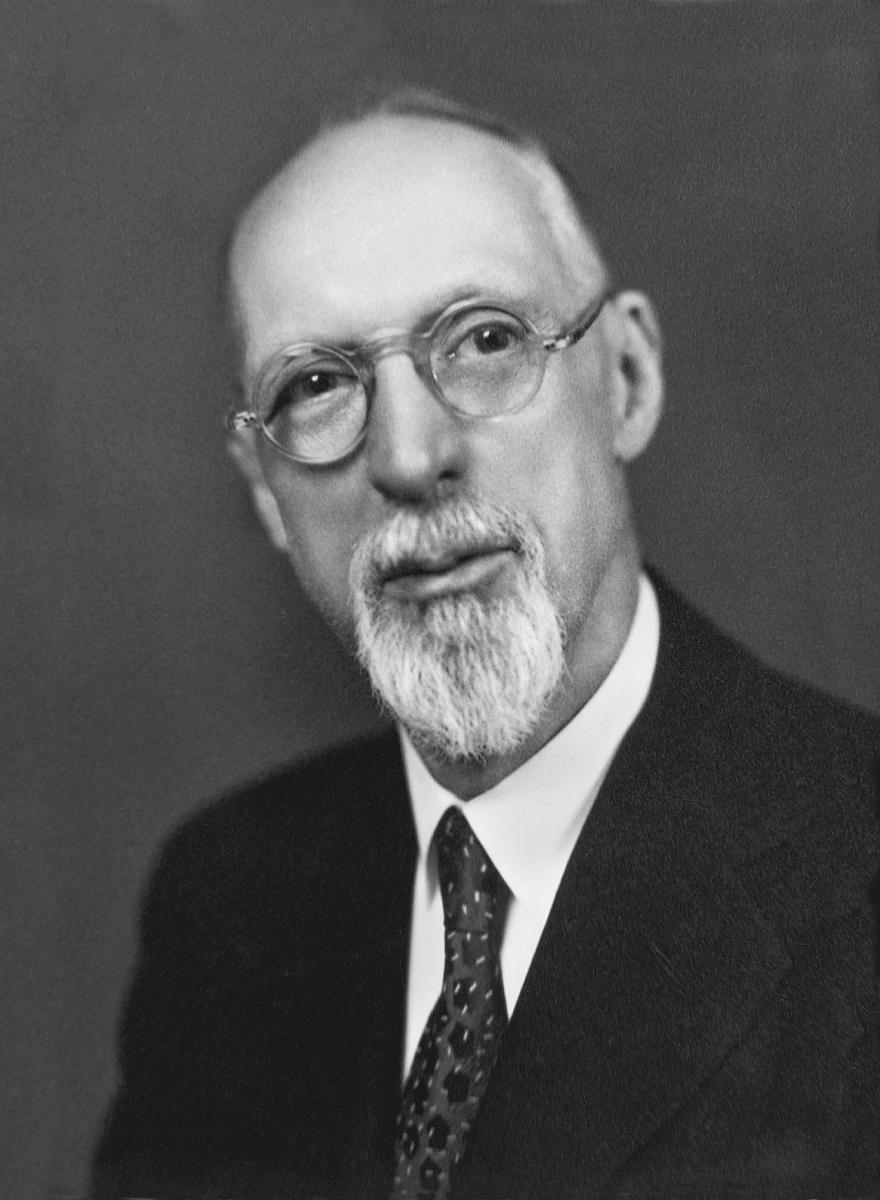 George Albert Smith was an active supporter of the Boy Scouts of America. (Church History Library.)
George Albert Smith was an active supporter of the Boy Scouts of America. (Church History Library.)
President George Albert Smith often went out of his way to be kind to others. In 1935, a missionary who recently returned from Europe was the recipient of that kindness. While serving in Europe, the missionary had helped to organize the first officially registered Boy Scout troops there. On his return trip to Utah after his mission, he followed the advice of his mission president and visited the Scouts’ national headquarters in New York City. Once inside the building, he asked to meet with one of the junior executives he had met during a Scouting jamboree. His acquaintance was not at work, but he was invited instead to meet with Dr. Fisher, Scouting’s chief executive officer. After a pleasant conversation, Dr. Fisher said, “We’re having [a] luncheon for the Baden-Powells [the British founder of the Boy Scouts program] at the Waldorf next Tuesday at 1:00 p.m. They are returning to England after a world tour of scouting. George Albert [Smith] has written for a table of ten, and I know he’ll want you at his table.” Elder Smith served as one of the national executive committee members for the Boy Scouts of America. The former missionary tried to defer by suggesting that Elder Smith “would have more important people to consider for the ten places than a stray missionary from Europe.” Dr. Fisher just laughed and said that he knew George Albert Smith better than the young man did. “You be at the Waldorf next Tuesday at 1:00 p.m.,” he said.
The following Tuesday when he arrived at the Waldorf Hotel, the returned missionary felt out of place and did not know anyone at the reception. Suddenly, George Albert Smith walked into the room, walked up to the young man, and said, “Brother?” The young man apologized for being an imposition. Elder Smith quickly replied, “Imposition? I should say not! I apologize to you for keeping you waiting. We have been busy in a meeting of the council. We became so involved that Dr. Fisher forgot to mention that you would join us until only a moment ago. Come right in, we’re about ready to begin!” George Albert Smith took him by the arm and led him over to a table at which were seated a number of prominent Latter-day Saint men who were leaders in the Boy Scout program. Before parting that evening, President Smith invited the returned missionary to meet with him at his office in Salt Lake City. The young missionary who benefited from President Smith’s kindness was G. Homer Durham, who later served as a member of the Presidency of the First Quorum of the Seventy.[20] Of that event in July 1935, Elder Durham wrote:
[This] event of July 16 was an insignificant incident in the annals of man, perhaps. But to the young man in the case it marked an experience, a soul-warming experience, that will live forever. He had been the recipient of a daily good turn by a man holding the Silver Beaver and the Silver Buffalo [Boy Scouting’s highest awards]. A busy man had gone out of his way to perform an act of recognition of another human being, a kindly act which said that the future can be friendly, not fear-filled nor insecure. A few weeks later in the offices of the Council of the Twelve, the same generous leader put his arm around the boy’s shoulder and offered some advice: “Remember, we’re living eternal lives.”[21]
Elder Durham later shared this summation of President George Albert Smith’s great kindness: “President Smith’s life was filled with daily good turns to his fellow men. His kindly deeds will become legendary and grow with the years. Many were poignant. More than a few have tremendous dramatic force. A few may have been pedestrian, but even if so, the kindly, soul-warming force behind each will live and grow.”[22] Glen Stubbs, one of President Smith’s biographers, wrote that George Albert Smith “was not one to shout his good deeds from the housetops, but those who knew him best, knew of his many unsolicited acts of kindness to the sick, the aged, the widow, the child, the student, the blind, the Church leader, the community, and to his family and friends. The prevalent theme of his life was service to humanity.”[23]
David O. McKay
Prior to being called as a General Authority, David O. McKay taught school at the Weber Academy in Ogden, Utah, and later served as the principal there. At the turn of the twentieth century, it was common for boys in Utah to withdraw from school each spring so that they could help their families with spring planting; then they would reenroll in the fall. One spring David invited anyone who needed to leave to come by his office to complete the necessary paperwork. By the end of the day, numerous farm boys visited his office “laughing, patting, shaking hands with him; all had come to withdraw, bound for spring planting.”
After all of the other boys had left the school, David noticed one redheaded boy standing alone. The boy walked up to his office door and said, “Sir, it looks like I’ll have to withdraw also. I just don’t have the means for the rest of the spring. I’m going to have to work full-time. But I’ll return later. I’m going to get an education.” Principal McKay recognized the boy as Aaron Tracy, a seventeen-year-old orphan who had received little previous schooling; he also knew that Aaron had already lived in a dozen foster homes. David approached Aaron and invited him to walk to his home with him—a two-story house just four blocks from the school. On the way, President McKay told Aaron, “My wife needs someone to help out around the house. I can use someone to milk the cow and drive the buggy and tend the horses. If you want to go get your things and move in with us we have a spare room upstairs.” After Aaron accepted the gracious offer, David said, “Let’s go home and explain to Mrs. McKay.” Aaron was given a set of chores—turning the washing machine, milking the cow, hitching the buggy, and driving Brother and Sister McKay. The McKays treated Aaron like one of their children. (Aaron later served as the president of Weber College in Ogden, Utah.)[24]
Joseph Fielding Smith
President Joseph Fielding Smith was very service oriented, but he provided that service quietly and out of the public eye whenever possible. He spent countless hours “counseling the lost and downtrodden,” wrote thousands of letters to answer gospel and scriptural questions that he received from Latter-day Saints, “paid hospital bills for the unfortunate, and sent groceries to the hungry and destitute.” On one occasion, after speaking during a missionary farewell, he learned that the missionary’s family had only been able to set aside half of the money needed to support their missionary. President Smith quietly instructed the missionary’s older brother to visit his office at Church headquarters every month to pick up a check for the remaining amount. “One month the missionary wrote home to say that he could get along on less than the usual amount that month, so his brother did not go in to pick up the check from President Smith. The next month when he went in to get the check, he received a stern scolding from President Smith who said, ‘You didn’t come last month to get your money, and I want you to know you have no right to deny me the blessing of helping that boy!’”[25]
Harold B. Lee
During the Great Depression, President Harold B. Lee played a key role in the creation and development of the Church welfare system. He felt keenly the needs of those families around him. One Christmas Day during the 1930s while he was serving as a stake president, his daughter ran across the street to show Donna Mae, her friend and neighbor, the new Christmas doll she had received. His daughter was crying when she returned home a few minutes later. When President Lee inquired as to the cause of her sadness, his daughter told him that her friend had not received anything for Christmas. “Santa Claus had not come to her house.” President Lee recalled almost forty years later, in a 1973 talk to Deseret Industries employees, that “too late, we remembered that the father of the family had been out of work. Although he was not a member of the Church, we tried to share our Christmas with the children. For me it was a very difficult Christmas. I did not enjoy the dinner that I sat down to that day, because I, as stake president, had not become acquainted with the people in my stake.”
To ensure that the problem would not be repeated the following year, President Lee said, “We made preparations. We made a survey, and we found that we had more than a thousand people who needed help during those difficult times. So we made ready by gathering toys and taking them to the old storehouse. Then the fathers and mothers came and helped fix the toys, putting them together, dressing dolls, and sewing things.” That Christmas his stake provided “oranges and apples. There was roast beef and all the trimmings for Christmas dinner. The bishops arranged to have it delivered to all the needy families, and then called me to let me know that all had been visited.” Commenting on the difference that their service had made, President Lee said, “That year when I sat down to my Christmas dinner I felt that I could enjoy it, because, as far as I knew, every family in my stake was having a good Christmas.”[26]
Spencer W. Kimball
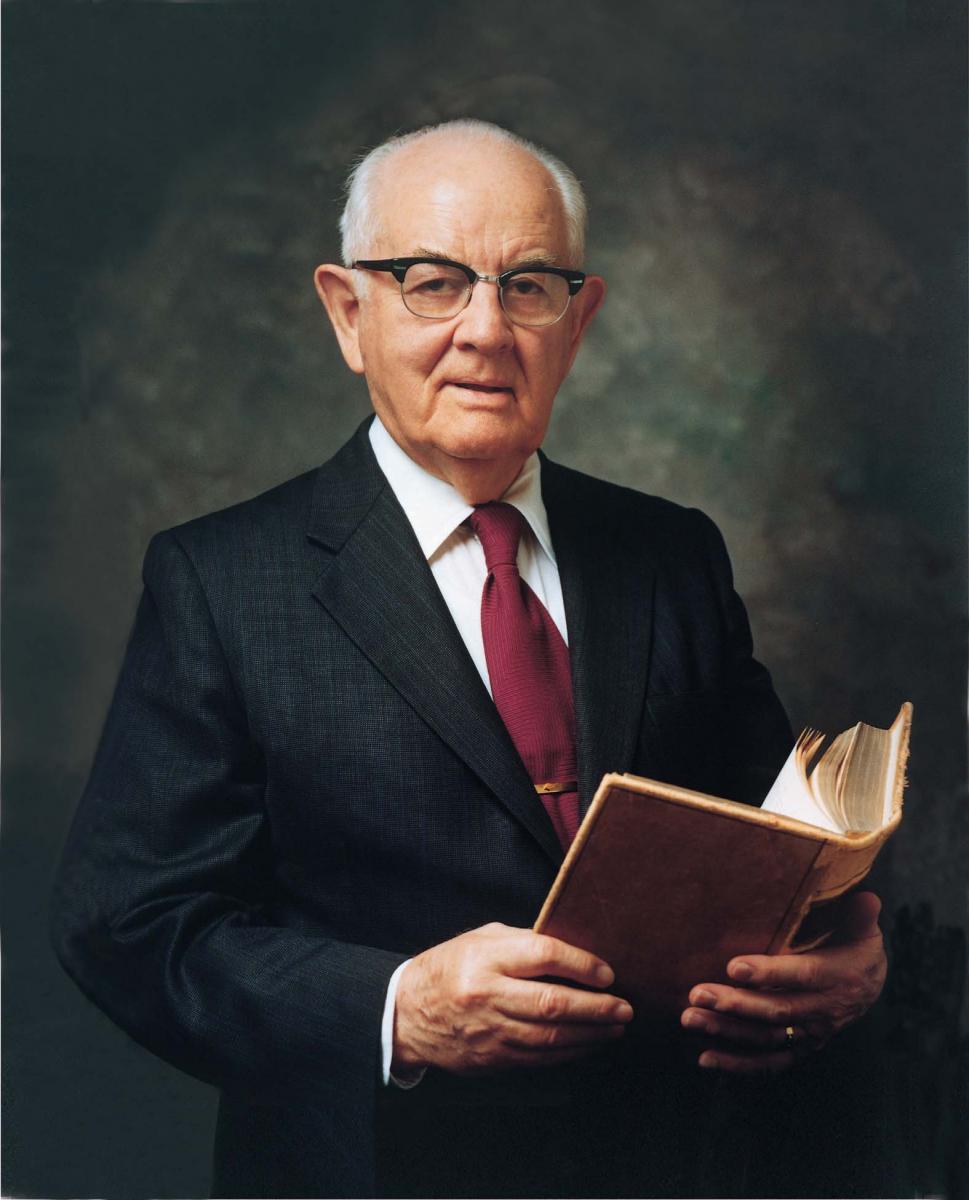 President Spencer W. Kimball was always concerned with the spiritual well-being of others. (Photo by Eldon Keith Linschoten).
President Spencer W. Kimball was always concerned with the spiritual well-being of others. (Photo by Eldon Keith Linschoten).
President Spencer W. Kimball suffered from ill health many times during his life. After being called to serve as an Apostle, he suffered a major heart attack and continued to experience chest pains for some time afterward. More than a year after his heart attack, he traveled to Arizona to recuperate. While there, he invited a friend “who seemed to be drifting spiritually” to go on a weekend camping trip with him. His friend offered to purchase the food they would need. Elder Kimball told him that they would not need any food because he hoped they would be fasting for the entire weekend. The friend, out of friendship to Spencer, still agreed to go. “They camped out from Saturday to Monday at a meadow in the high mountains, read the scriptures, prayed, and talked.” When it was time to leave on Monday, their car would not start. After a combination of tinkering and prayer, their car finally started, and President Kimball was pleased to later learn that his friend had returned to active membership in the Church.[27]
Ezra Taft Benson
Sheri L. Dew shared an incident from President Benson’s life that provides an insight into his priorities. On a four-hour visit in 1979 to Athens, Greece, President Benson learned about a Greek member of the Church who had refused to renounce the Church even though he had been placed under intense pressure to do so. The man’s children had been refused admittance to school, and his business was boycotted. At some point during the persecution, the man had become inactive. Even though he had just a few hours in the city, President Benson got a car and drove across Athens to visit with the man. Imagine the man’s shock and surprise when he answered the knock at his door and found Ezra Taft Benson, President of the Quorum of the Twelve Apostles, standing in his doorway.
One of the men traveling with President Benson described the meeting: “President Benson wanted to hear this man’s story from his own lips. The President was very moved by what he heard. Before we left, President Benson pulled this man to him and said, ‘God bless you, my brother. I want you to know our prayers are with you.’ The man had tears in his eyes. As we left, President Benson turned to me and told me to take down his name, his family’s name, and the names of his children, and immediately when we returned, to put them on the temple prayer roll.”
The district president from Athens visited Salt Lake City several months later and reported “the rest of the story.” The boycott had been lifted. The children were able to return to school, and the man was active in the Church again. As President Benson’s assistant summarized the experience, “President Benson gave that brother who’d been discouraged and downtrodden the courage to come back.”[28]
Howard W. Hunter
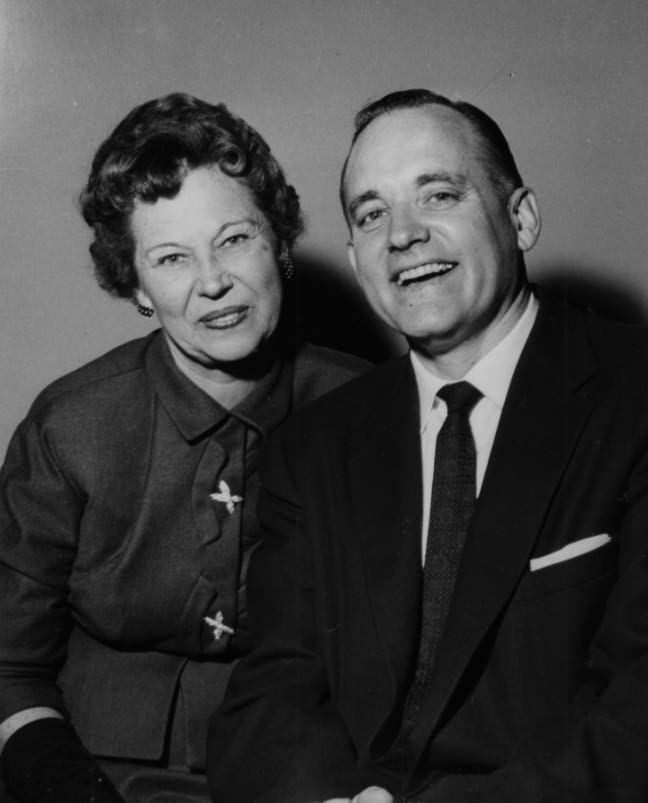 Howard W. Hunter provided loving care to his wife, Claire Jeffs Hunter, during the last several years of her life.
Howard W. Hunter provided loving care to his wife, Claire Jeffs Hunter, during the last several years of her life.
Although he was Church President for only nine months, Howard W. Hunter served as an Apostle for over three and a half decades. During twelve of those years, he provided significant care for his wife, Claire, who grew increasingly ill. Her medical challenges began in the early 1970s with severe headaches and memory loss. In February 1973, doctors discovered a blood clot in her neck. In 1975 her left lung collapsed, and she had significant chest and arm pain that led to her needing to have surgery. Elder Hunter visited her hospital bed three times every day for many weeks. After leaving the hospital, tests revealed that Claire had developed adult-onset diabetes, and Howard learned how to do the necessary blood tests for her at home. As her health continued to deteriorate, Elder Hunter insisted that he provide all of her care at night, which meant that he received little sleep for many years while carrying significant responsibilities as an Apostle. In 1981, Claire had a cerebral hemorrhage and lost the ability to walk. By April 1982, her health declined to the point where she had to be moved into a nursing home. Elder Hunter visited her several times every day that he was not required to be out of town on apostolic business. Claire passed away in October 1983. According to his biographer, Eleanor Knowles, President Hunter remained supportive and optimistic through all of the adversity. President James E. Faust noted, “At times she would smile and respond only to Howard. The tenderness which was evident in their communication was heart rending and touching. I have never seen such an example of devotion of a husband to his wife.”[29]
Gordon B. Hinckley
During the Vietnam War, Elder Gordon B. Hinckley traveled to Da Nang, South Vietnam, to meet with and strengthen Latter-day Saint servicemen. After arriving at Da Nang, Elder Hinckley was driven to a Quonset hut that served as a chapel. Over one hundred LDS soldiers came to meet with him. As the soldiers entered the small metal chapel, they stacked their M-16 rifles on the back two rows and sat down to hear an Apostle of the Lord. Elder Hinckley later wrote, “I shall never forget that picture or that meeting. What a sight they were! What a wonderful group, these young brethren of ours. We loved them the minute we looked into their eyes.”[30]
Three LDS servicemen had been killed during the previous week, and “Elder Hinckley began the meeting with a memorial service and concluded by inviting anyone who so desired to bear his testimony.”[31] As he talked to the servicemen, Elder Hinckley offered to contact their family members and loved ones back home. Nearly every soldier entered a phone number on the sign-up sheet that was passed through the attendees. As one officer commented, “Elder Hinckley made us feel that we weren’t forgotten. His visit boosted our morale in a phenomenal way. He made us feel that we were good, honest men, and that what we were doing was honorable.” Of that event, Elder Hinckley wrote in his journal that it was “an experience both wonderful and depressing to be so close to these good young men, men who hold and honor the priesthood, men who are valiantly doing their duty as citizens of this country, but who would rather be doing something else. I thought as I talked with them that they ought to be in school . . . rather than walking fearsome patrols in the dark of the Asian jungle where death comes so quickly and quietly and definitely.” And he continued:
These are the kids who ran and laughed and played ball back home, who drove the highways in old jalopies, who danced with lovely girls at the Gold and Green balls, who administered the sacrament on Sunday. These are boys who come from good homes where the linen is clean and showers are hot, who now sweat night and day in this troubled land, who are shot at and who shoot back, who have seen gaping wounds in a buddy’s chest and who have killed those who would have killed them. I thought of the terrible inequality of sacrifice involved in the cause of human liberty.[32]
Thomas S. Monson
Stories of President Monson’s compassionate service are legion. President Monson “understands what the Lord requires: simple willingness to serve people, to look in the forgotten corners, down the dark streets, and into the eyes that seem to have lost hope.”[33] During the 1970s when the Iron Curtain and the Berlin Wall were still standing, members of the Church who lived in the German Democratic Republic (GDR) were not allowed to leave their country’s borders, which made it impossible for them to receive their temple ordinances. During one of his many visits to the GDR, Elder Monson found himself sitting in a car with Gunther and Inge Schulze, who were faithful third-generation members of the Church. When Elder Monson suggested that the Church could send a letter of invitation for them to visit a temple outside of East Germany, they replied, “Our position is too sensitive here.” As they were parting, Elder Monson called them back to him and said: “I feel that the Lord would like to see you endowed in His holy house. You are worthy people; you are exemplary in your conduct; you are faithful in the pursuit of Church responsibilities. Let’s trust in the Lord. Let’s allow our faith to exceed our doubt.” Elder Monson reported that they then “knelt in the parking lot in the rain and poured out [their] hearts to God.” The temple invitation was sent, and surprisingly, the East German government allowed Brother and Sister Schulze to attend the temple.[34]
Summary
In Acts 10:38, Peter explained to Cornelius that Jesus of Nazareth was someone “who went about doing good, . . . for God was with him.” First as an Apostle and later as leader of the Church in the meridian of time, Peter demonstrated great humility through the service that he provided to others. Peter sought to emulate Christ in this and numerous other ways. Likewise, the prophets who have served in our dispensation have followed Peter’s charitable example. As President Spencer W. Kimball once explained, “the more we serve our fellowman in appropriate ways, the more substance there is to our souls. . . . We become more substantive as we serve others—indeed, it is easier to ‘find’ ourselves because there is so much more of us to find!”[35] The sixteen Presidents of The Church of Jesus Christ of Latter-day Saints have demonstrated that there is, indeed, substance to their souls.
Notes
[1]“Although John Mark is possible, John is probably the son of Zebedee.” Charles M. Laymon, ed., The Interpreter’s One-Volume Commentary on the Bible (New York: Abingdon Press, 1971), 732.
[2] There is some uncertainty regarding the exact location of the Beautiful Gate. Luke Timothy Johnson, for example, suggests that “we cannot be sure of this gate’s identity. Josephus mentioned a ‘Bronze Gate’ on the east side of the temple in Jewish War 2:411, and specifically stresses its value as being greater than those ‘plated with silver and gold,’ since it was made of Corinthian bronze (Jewish War 5:201), but he never mentions a gate called ‘Beautiful.’ . . . Does he [Luke] intend his readers to catch a play on the ‘silver and gold’ associated with the temple gates?” Luke Timothy Johnson, The Acts of the Apostles, Sacra Pagina Series, vol. 5, ed. Daniel J. Harrington (Collegeville, MN: The Liturgical Press, 1992), 65. The biblical scholar Johannes Munck adds that “it is uncertain whether the gate was placed at the entrance to the temple grounds or as an entrance to the temple buildings.” Johannes Munck, The Anchor Bible: The Acts of the Apostles, rev. William F. Albright and C. S. Mann (New York: Doubleday, 1967), 24–25. Other scholars feel more certain regarding the gate’s location. Reverend James M. Freeman, for example, equates the “Gate Beautiful” with the “Gate Susan” and identifies it as the entrance to the Court of the Women. See Rev. James M. Freeman, Manners and Customs of the Bible (Plainfield, NJ: Logos International, 1972), 373.
[3] As an aside, the King James Version implies that the lame man was already in position begging for alms (see Acts 3:2) when Peter and John noticed him. Other translations imply that the lame man was actually “being carried to the temple court” (New International Version) when the initial contact occurred.
[4] Like many cultures in the ancient world, Jews in Peter’s time divided daylight into hours with “each of these hours being one twelfth of the time between sunrise and sunset. Thus the hours varied in length according to the time of year, the summer hours being longer than those of winter. . . . The first hour began at sunrise, the sixth ended at noon, and the twelfth ended at sunset. The third hour divided the period between sunrise and noon, and the ninth between noon and sunset. . . . The ‘ninth hour’ . . . was about three o’clock P.M.” See Freeman, Manners and Customs of the Bible, 429–30. Some biblical translations simply replace “the ninth hour” in Acts 3:1 with “three in the afternoon” (New International Version) or “the three o’clock daily prayer meeting” (Living Bible). See also The Interpreter’s One-Volume Commentary on the Bible, 732.
[5]“The evening temple service goes back to the instructions of Exodus 29:38–42; Numbers 28:1–8; see Josephus, Antiquities of the Jews, 14:66. That it was also a traditional time for prayer is suggested by Daniel 6:10; 9:21, and m. Tamid 5:1; 6:4.” Johnson, The Acts of the Apostles, 64.
[6] Luke Timothy Johnson notes that the “sharing of possessions through almsgiving (eleēmosynē) was an important expression of ‘doing justice (sedekâ = dikaiosynē)’ in Judaism.” Johnson, The Acts of the Apostles, 65.
[7] Laymon, The Interpreter’s One-Volume Commentary on the Bible, 732.
[8]“The use of the adverb parachrēma (‘immediately’) is typical for Lukan wonders (Luke 1:64; 4:39; 8:44, 47, 55; 13:13; 18:43; Acts 5:10; 12:23; 13:11). Again, its use in the Gospel healing of the paralytic (Luke 5:25) is especially noteworthy.” Johnson, The Acts of the Apostles, 66.
[9]“The response of ‘praising God’ is typically Lukan (Luke 2:20; 5:25–26; 7:16; 13:13; 17:15; 18:43).” Johnson, The Acts of the Apostles, 66.
[10] Quoted by Eldred G. Smith, in Conference Report, April 1967, 77.
[11]“Recollections of the Prophet Joseph Smith,” Juvenile Instructor 27, no. 5 (March 1, 1892): 153.
[12] Benjamin L. Rich, Ben E. Rich: An Appreciation by His Son (Salt Lake City: n.p., 1950), 32–33. The boy was Ben E. Rich, son of Elder Charles C. Rich who was serving as president of the Church’s British Mission.
[13] John Taylor, in Conference Report, April 1880, 61–65.
[14] Wilford Woodruff, Leaves from my Journal (Salt Lake City: Juvenile Instructor Office, 1882), 53–55.
[15] Lorenzo Snow married Phoebe Amelia Woodruff, daughter of Wilford Woodruff, on April 4, 1859.
[16] Eliza R. Snow Smith, Biography and Family Record of Lorenzo Snow (Salt Lake City: Deseret News Company, 1884), 128–29.
[17] Snow, Biography and Family Record of Lorenzo Snow, 128–29.
[18] Joseph Fielding Smith, comp., Life of Joseph F. Smith (Salt Lake City: Deseret Book, 1969), 441.
[19] Leonard J. Arrington, ed., The Presidents of the Church (Salt Lake City: Deseret Book Company, 1986), 246–47.
[20] G. Homer Durham, “A Daily Good Turn,” Improvement Era 54, no. 6 (June 1951): 386, 478–79.
[21] Glen R. Stubbs, “A Biography of George Albert Smith, 1870 to 1951” (PhD diss., Brigham Young University, 1974), 277.
[22] Durham, “A Daily Good Turn,” 479.
[23] Stubbs, “A Biography of George Albert Smith,” 269.
[24] Keith Terry, David O. McKay: Prophet of Love (Santa Barbara, CA: Butterfly Publishing Inc., 1980), 55–56.
[25] Joseph F. McConkie, True and Faithful: The Life Story of Joseph Fielding Smith (Salt Lake City: Publishers Press, 1972), 72.
[26] Leonard J. Arrington, “Harold B. Lee,” in The Presidents of the Church, 357–58.
[27] Edward L. Kimball, “Spencer W. Kimball,” in The Presidents of the Church, 396.
[28] Sheri L. Dew, Ezra Taft Benson: A Biography (Salt Lake City: Deseret Book, 1987), 435–36.
[29] Eleanor Knowles, Howard W. Hunter (Salt Lake City: Deseret Book, 1994), 264–71.
[30] Sheri L. Dew, Go Forward with Faith: The Biography of Gordon B. Hinckley (Salt Lake City: Deseret Book, 1996), 274–75.
[31] Dew, Go Forward with Faith, 274–75.
[32] Dew, Go Forward with Faith, 274–75.
[33] Heidi S. Swinton, To the Rescue: The Biography of Thomas S. Monson (Salt Lake City: Deseret Book, 2010), 145.
[34] Swinton, To the Rescue, 304.
[35] Spencer W. Kimball, “Small Acts of Service,” Ensign, December 1974, 2.
